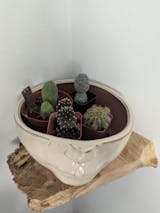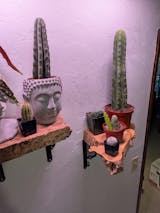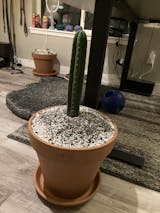Trichocereus cacti, while hardy and resilient, aren't exempt from the challenges posed by pests and diseases. Understanding these threats and knowing how to counteract them is essential for keeping your cacti thriving. In this guide, we'll explore common issues and provide solutions to ensure the health of your Trichocereus.
1. Mealybugs
These tiny, white, cotton-like pests suck sap from the cactus, leading to weak and stunted growth.
Solution: Use a soft brush or cloth to remove them manually. For severe infestations, consider applying insecticidal soap or neem oil.
2. Spider Mites
Identifiable by fine webbing on the cactus, these pests also suck out sap, causing the cactus to appear dull and lifeless.
Solution: Increase humidity around the cactus or use a water spray to disrupt their habitat. Insecticidal soaps can also be effective.
3. Scale Insects
These pests appear as small, flat, brown, or white discs on the cactus. Like the others, they feed on the plant's sap.
Solution: Remove manually with a soft brush or treat with insecticidal soap.
4. Root Rot
A common issue, particularly if the cactus is overwatered or the soil doesn't drain well. Symptoms include a soft, mushy base and discoloration.
Solution: Ensure you're using a well-draining soil mix. If root rot is detected, remove the affected parts, let the cactus dry out, and then repot in fresh soil.
5. Fungal Diseases
Manifested as black or brown spots on the cactus, they're usually a result of excessive moisture or poor ventilation.
Solution: Reduce watering and ensure the cactus has adequate ventilation. Fungicidal sprays can also help in controlling the spread.
Diverse Trichocereus Varieties: Different Care Needs
While all Trichocereus cacti have some general care guidelines, specific varieties might have particular needs. For instance:
- Bridgesii and Peruvianus: Known for their robust nature, they're less susceptible to pests but still require vigilance.
- Monstrose and Crested: Their unique growth patterns might harbor pests in crevices, so regular inspections are crucial.
- Cuzcoensis and Huanucoensis: Being rare, they might need specialized care to ensure they remain healthy.
To ensure you're equipped with the right knowledge and tools, consider sourcing your Trichocereus from experts. At The Succulent Source, not only will you find a diverse range of Trichocereus species, but also the guidance to care for them best.
Conclusion
While Trichocereus cacti are generally low-maintenance, being proactive about potential threats ensures they remain healthy and vibrant. Regular inspections, proper watering habits, and prompt interventions can keep pests and diseases at bay. And, for the best Trichocereus specimens and care tips, turn to the trusted experts at The Succulent Source.





